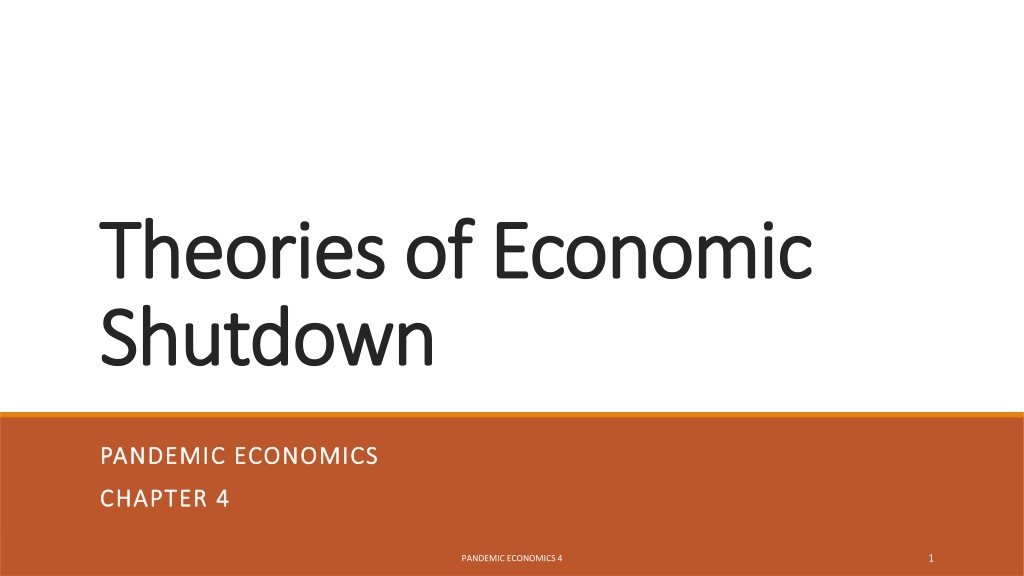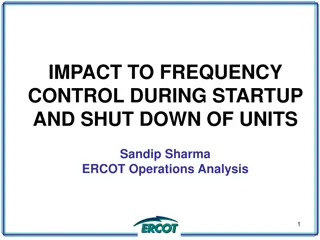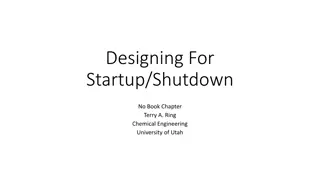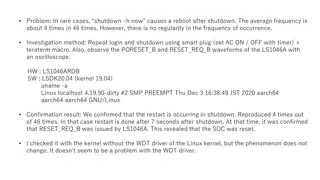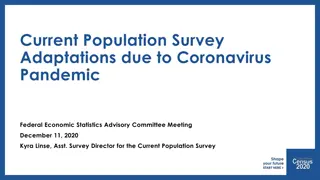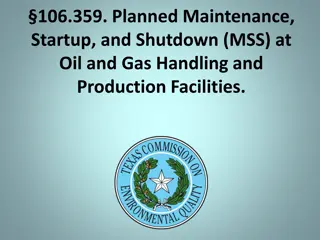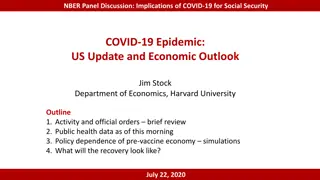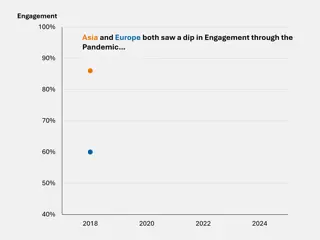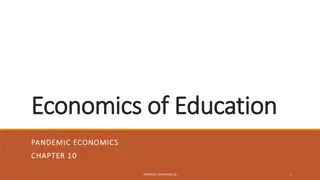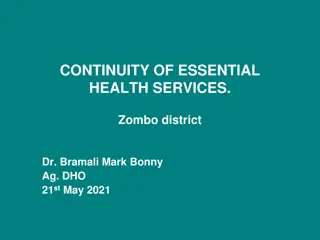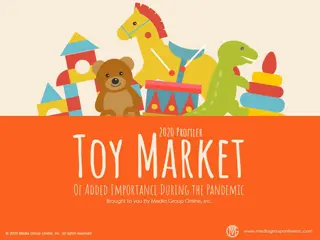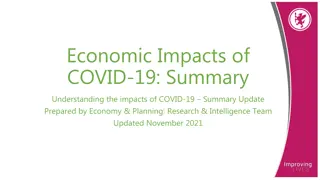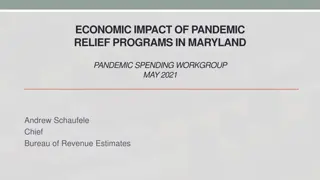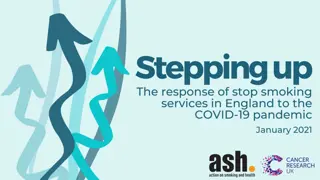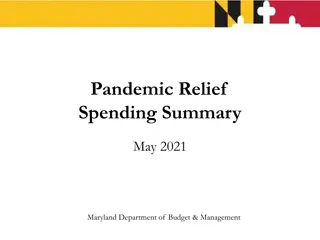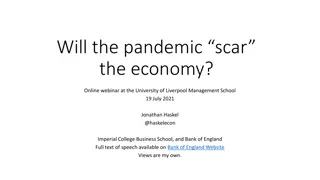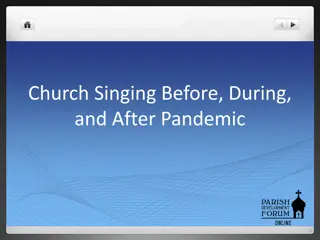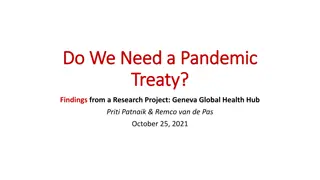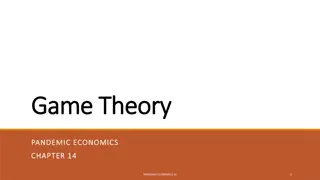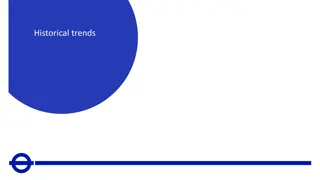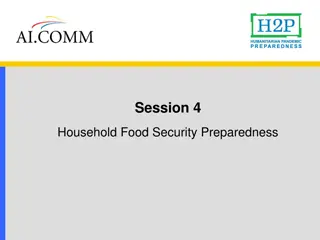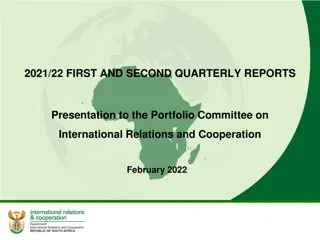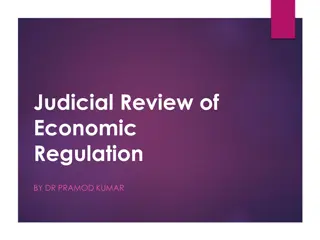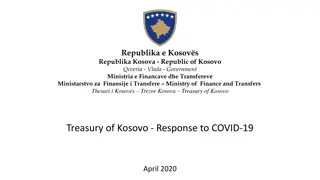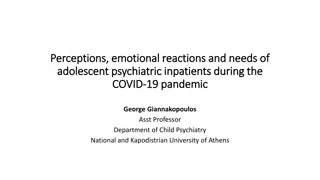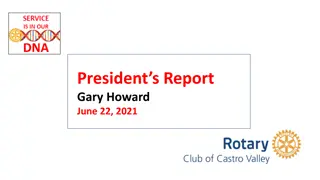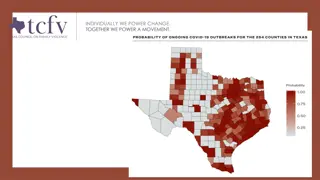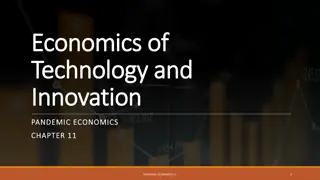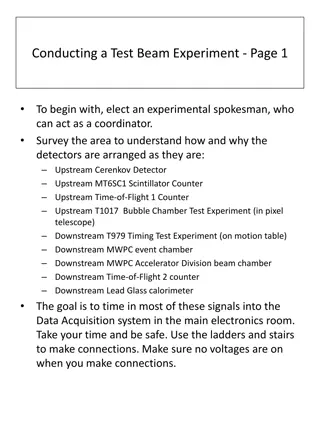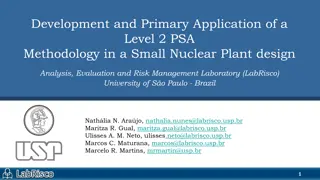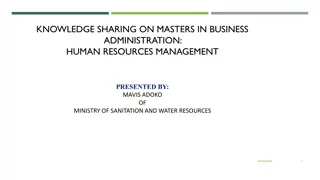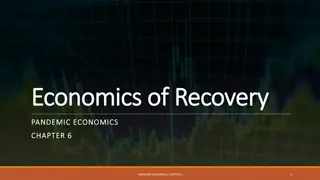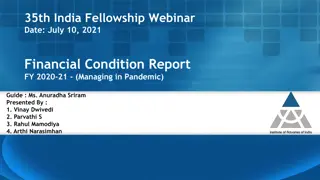Understanding Economic Shutdown Strategies During a Pandemic
This chapter delves into the economic implications of pandemic shutdowns, exploring topics such as the shutdown interval, flattening the epidemic curve, non-pharmaceutical interventions, and the tradeoff between economic health and public health. It analyzes the impact on labor markets, income loss, and different models of economic assistance, emphasizing the need to prioritize health over wealth in such crises.
Download Presentation

Please find below an Image/Link to download the presentation.
The content on the website is provided AS IS for your information and personal use only. It may not be sold, licensed, or shared on other websites without obtaining consent from the author. Download presentation by click this link. If you encounter any issues during the download, it is possible that the publisher has removed the file from their server.
E N D
Presentation Transcript
Theories of Economic Theories of Economic Shutdown Shutdown PANDEMIC ECONOMICS PANDEMIC ECONOMICS CHAPTER 4 CHAPTER 4 1 PANDEMIC ECONOMICS 4
Topics Topics 1. Shutdown Interval 2. Flattening the Epidemic Curve 3. Non-Pharmaceutical Interventions 4. Tradeoff Between Health and the Economy 5. Theories of Economic Shutdown 6. Health Before Wealth 7. Labor Market and Lost Income 8. Economic Systems and Income Assistance 2 PANDEMIC ECONOMICS 4
Learning Objectives Learning Objectives After reading this chapter, you will be able to: After reading this chapter, you will be able to: LO1 Discuss the first economic interval of the pandemic phase: shutdown. LO2 Explain why flattening the epidemic curve serves as an epidemiological goal. LO3 Analyze non-pharmaceutical interventions. LO4 Address the tradeoff between economic health and public health. LO5 Contrast theories of economic shutdown. LO6 Explain why countries should prioritize health before wealth. LO7 Determine the loss in income when laborers shelter-in-place. LO8 Analyze models of economic assistance. 3 PANDEMIC ECONOMICS 10
1. Shutdown Interval 1. Shutdown Interval This chapter analyzes the first economic interval of the pandemic phase: shutdown. 4 PANDEMIC ECONOMICS 4
Shutdown Interventions Shutdown Interventions To reduce infections, slow the spread of the disease, and decrease the number of deaths, shutdown interventions limit human contact. For most countries, shutdown interventions follow a script: non- essential members of the labor force stop reporting to their places of employment, while essential workers remain. But when non-essential workers leave, they may or may not remain employed with their companies. 5 PANDEMIC ECONOMICS 4
Flattening the epidemic curve, a public health strategy of protective measures, attempts to slow the spread of disease. After an outbreak, infections rise, peak, and decline. 2. Flattening 2. Flattening the Epidemic the Epidemic Flattening the epidemic curve leads to both a delay in peak infections and a lower number of peak cases. Curve Curve When the epidemic curve flattens, it takes longer for infections to spread through a population. 6 PANDEMIC ECONOMICS 4
The Arguments for Flattening the Epidemic Curve The Arguments for Flattening the Epidemic Curve First, slowing the spread of disease provides time for a network of scientists to create a vaccine and other treatments. With a susceptible population, infections rise exponentially at the beginning of a pandemic. Second, slowing the spread of disease addresses the potential of shortages in capacity in hospitals. When cases rise, hospitals may not have the capacity to treat all of the patients or enough resources necessary to fight the disease, including doctors, nurses, and protective equipment. 7 PANDEMIC ECONOMICS 4
Non-pharmaceutical interventions flatten the epidemic curve. They sever transmission networks before the creation and distribution of a vaccine. In this context, physical distancing serves as the primary mechanism to slow the spread of disease. But the interventions differ with respect to structure, function, and income effects. 3. Non 3. Non- - Pharmaceutical Pharmaceutical Interventions Interventions 8 PANDEMIC ECONOMICS 4
Sheltering Sheltering- -in in- -Place Place With a sheltering-in-place directive, people remain home for all but essential activities, including work, care for others, and trips to grocery stores and pharmacies. As an alternative to quarantine, sheltering-in-place separates individuals to stop the spread of disease. The difference, however, is that sheltering-in-place provides more flexibility. 9 PANDEMIC ECONOMICS 4
S Social Distancing ocial Distancing The process of physical or social distancingmeans maintaining an acceptable amount of space, believed to be six feet (1.83 meters), between individuals. With social distancing, individuals may work, shop for groceries and pharmaceuticals, and exercise, while avoiding infection. Especially important for people in high-risk categories, such pre- existing medical conditions or less access to healthcare services, the motivation for social distancing is that asymptomatic cases may spread disease to others without knowledge. 10 PANDEMIC ECONOMICS 4
Quarantines Quarantines A state, period, or place of quarantine is characterized as the deliberate separation of individuals exposed to a contagious agent During a pandemic, a percentage of the exposed individuals are sent to quarantine. Monitoring demonstrates who shows symptoms or tests positive. 11 PANDEMIC ECONOMICS 4
4. Tradeoff 4. Tradeoff Between Health Between Health and the and the Economy Economy If a country prioritizes public health, shuts down segments of the economy, and fights the spread of disease, the country must eventually ease restrictions on economic activity. At this point, further improvements in the economy may come at the expense of public health. 12 PANDEMIC ECONOMICS 4
Assimilation of Workers Assimilation of Workers The tradeoff between health and the economy stems from the fact that countries must eventually ease restrictions and open the segments of the economy that were closed. The idea is to assimilate workers back into the economy. But higher levels of economic activity lead to more human interaction and the potential for additional infection waves. At this point, the benefit of economic activity must be weighed against the cost of a subsequent decline in public health. 13 PANDEMIC ECONOMICS 4
Sub Sub- -Optimal Position Optimal Position When workers re-emerge from their homes after sheltering-in- place, they experience an economy operating in a sub-optimal position with less production and consumer spending. One reason is that, on the supply side of the market, pandemics sever global supply chains. Another reason is that, on the demand side of the market, households reduce spending on services, such as restaurant meals and haircuts. 14 PANDEMIC ECONOMICS 4
Tradeoff Between Public Health and the Economy Tradeoff Between Public Health and the Economy The tradeoff between public health and the economy depends on the relationship between shutdown interventions and economic activity. For businesses that rely on face-to-face interaction, such as hair salons and dentists, shutdown policies reduce economic activity. Empirically, the benefit to society of shutdown interventions is the present value of lives saved, measured as the difference in mortality between shutdown and no shutdown policies. The cost to society is the present value of a decline in G.D.P. 15 PANDEMIC ECONOMICS 4
Early in a pandemic, countries may choose to shutter all, some, or no parts of the economy. In practice, policies of economic shutdown relate to the epidemic curve. A full economic shutdown flattens the curve in the most substantial manner. But the prioritization of public health may take different forms. 5. Theories of 5. Theories of Economic Economic Shutdown Shutdown 16 PANDEMIC ECONOMICS 4
Spectrum of Choices Spectrum of Choices Different theories of economic shutdown demonstrate the extent to which interventions shutter the business environment, lead to tradeoffs between public health and the economy, and exist along a spectrum of choices. 17 PANDEMIC ECONOMICS 4
NO ECONOMIC SHUTDOWN TARGETED ECONOMIC SHUTDOWN The theory of not shutting down any businesses is to build herd immunity as quickly as possible when a critical mass of infections thwarts transmission. Protects public health with less economic cost than a comprehensive shutdown. The idea is that cities should keep businesses open if the chance of spreading the disease among these businesses is low and the economic cost of closing the businesses is high. With this option, a country does not attempt to flatten the epidemic curve. 18 PANDEMIC ECONOMICS 4
COMPREHENSIVE ECONOMIC SHUTDOWN Distinguishes between essential and non- essential workers. FULL ECONOMIC SHUTDOWN The most extensive intervention prioritizes public health, shutters all business activity, and creates the highest economic costs. Essential workers those engaged with the safety of human life continue to operate in their physical workspace. A full economic shutdown flattens the epidemic curve in the fastest manner. Non-essential workers who do not have to be physically present in the workspace for a city to function are sent home to engage in remote work. 19 PANDEMIC ECONOMICS 4
Stringency Index Stringency Index To compare shutdown policies between countries, Oxford University developed the Oxford Covid-19 Government Response Tracker, a stringency index, which provides a cross-national and cross-temporal method to measure the evolution of government responses. The tracker tabulates government policies across 19 indicators. The stringency index uses the indicators each assigned a number between 0 and 100 to represent the government s response to calculate an overall score. 20 PANDEMIC ECONOMICS 4
21 PANDEMIC ECONOMICS 4
Stringency Stringency Index for the Index for the U.S. and U.K. U.S. and U.K. During 2020 During 2020 22 PANDEMIC ECONOMICS 4
Stringency Scores and Epidemiological Outcomes Stringency Scores and Epidemiological Outcomes Countries that limit the spread of disease impose strong shutdown measures early in the pandemic (with higher stringency scores) and then transition to a testing- and information-based focus to encourage defensive behavior among individuals. Statistically, the earlier a country implements a comprehensive set of policy interventions, the larger is the decrease in the cumulative infection growth rate. 23 PANDEMIC ECONOMICS 4
Health Health- -Economy Tradeoff Economy Tradeoff The stringency index reveals a country s preference for the health- economy tradeoff. The shutdown approaches, as measured by the stringency index, demonstrate a preference along the health-economy production frontier, where the highest possible score represents a complete focus on health and the lowest possible score represents a complete focus on the economy. 24 PANDEMIC ECONOMICS 4
25 PANDEMIC ECONOMICS 4
Economists think at the margin, meaning they consider the implication of a decision or policy moving the economy in one direction or another. This type of thinking narrows the process of analysis. 6. Health 6. Health Before Wealth Before Wealth For example, with economic shutdown policies, thinking at the margin implies a tradeoff between the economy and public health: reducing infections by closing businesses leads to a decrease in economic activity. 26 PANDEMIC ECONOMICS 4
Caveats Caveats In a pandemic, thinking at the margin has caveats. Early in a pandemic, countries should not trade lives for economic livelihood. Instead, to fight the disease, countries should prioritize public health. Countries that intervene earlier and more aggressively experience faster economic recoveries. 27 PANDEMIC ECONOMICS 4
Reasons for Prioritizing Health Before Wealth Reasons for Prioritizing Health Before Wealth First, a pandemic hollows out the ability of a country to balance public health and the economy. Second, the options for prioritizing public health may drift away from their original position. 28 PANDEMIC ECONOMICS 4
29 PANDEMIC ECONOMICS 4
HOLLOWING OUT DRIFTING AWAY As the pandemic worsens, health costs rise, and the economy declines even further, demonstrated by point f in the right-hand side graph. The new and inward production possibility frontier possesses a shallow curve between points f and g, which arises from the pandemic and represents the concept of hollowing out. 30 PANDEMIC ECONOMICS 4
Labor supply represents marginal resource cost (MRC), the additional cost to the firm of employing one more unit of labor. Labor demand represents marginal revenue product (MRP), the additional revenue to the firm from the employment one more laborer. 7. Labor 7. Labor Market and Market and Lost Income Lost Income In the shutdown interval, businesses close. As a result, labor demand decreases, shifting left to MRP1. Employment declines from Le to Le1. Wages decline from We to We1 (following graph). 31 PANDEMIC ECONOMICS 4
32 PANDEMIC ECONOMICS 4
When countries shut down segments of their economies, they must provide financial assistance. Financial assistance is critical to align public health with economic expectations. A society s view of the role of government informs the models of income assistance. 8. Economic 8. Economic Systems and Systems and Income Income Assistance Assistance 33 PANDEMIC ECONOMICS 4
EUROPEAN MODEL U.S. MODEL Workers remain tied to their places of employment. Comparable to its European counterpart in terms of providing financial assistance, it differs in two ways. The objective of the model is to maintain the economy s level of employment. First, it offers an alternative relief program. During economic shutdown, businesses continue to pay workers, aided by government reimbursement. Second, it does not avoid layoffs. 34 PANDEMIC ECONOMICS 4
